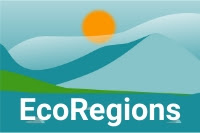What Are Ecoregions?
At the Sustainable Gardening Institute, we’re confident that most homeowners would prefer to have an eco-friendly garden landscape based on solid science, if they knew what to do. But even as they yearn for healthy, chemical-free surroundings, questions arise. Questions such as, “Where do I start?”
From where you are right now. Right where you’re standing. At ground level.
Learning the basics of your specific ecoregion and plant hardiness zone now will save you time, effort, and heartbreak later because that is the foundation for selecting plants that are easier to grow and more likely to succeed. It doesn’t matter whether you’re planning a garden for your own backyard or a landscape project for huge business campus, the basics are the same.
In this post, we’ll define what an ecoregion is, then explain why ecoregions are important in sustainable gardening, how they can be useful to both home gardeners and professionals alike, and get you started using ecoregions in your next landscape project.
 |
| Antelope Canyon is located in the Arizona/New Mexico Plateau Ecoregion |
What is an ecoregion?
Ecoregions are distinct geographic regions that contain a characteristic variety of plant and animal species, soils, watershed types, and land forms.Why are ecoregions important for choosing what plants to grow?
Ecoregions are important for choosing what plants to grow because plant health depends on many factors, including climate, soil type, terrain, and how water flows through the landscape.
Why are ecoregions important for sustainable gardening?
The ultimate goal for homeowners who want to grow Earth-friendly flowers or food in their yard is a garden that is not only beautiful, but also provides food and shelter for pollinators, habitat for wildlife, allows rainwater to percolate back into the ground, and encourages natural soil organisms to flourish. Gardens like this are sustainable, meaning they don’t require a lot of chemical inputs (such as fertilizers or pesticides) to stay healthy. Ecoregions, when combined with hardiness zones, provide important clues about which plants will do that more easily and help you select plants that thrive in your neck of the woods.A classic case of what a difference a few feet can make is right in my own back yard – well, actually across the road. Steep cliffs of Martinsburg Shale on this side; the Great Limestone Valley on the other. The limestone fens, seeps, and alkaline gravelly soils support entirely different plant communities from those in our acidic, dense, shallow clay.
On a larger scale, municipal, county, or state engineers and planners, environmental consultants, green industry specialists, and landscape professionals will want to integrate this information into their master plans and development projects to make them more efficient and effective.
“I look at the combination of hardiness and eco-regions as a possible major tool to effectively communicate about WHICH plants would work for people. We’ve all had to be so general in the past that it’s not that helpful. This tool could help with hyper-local plant recommendations even if it’s outside the region one typically works. Thanks for your work so far, it’s exactly the tool I needed at this point.”
Cynthia Bee
Outreach Coordinator
Jordan Valley Water Conservancy District
Outreach Coordinator
Jordan Valley Water Conservancy District
The U.S. Department of Transportation website recommends the use of ecoregions to determine appropriate vegetation management along roadside rights-of-way: https://www.environment.fhwa.dot.gov/env_topics/ecosystems/veg_mgmt_rpt/vegmgmt_ecoregional_approach.aspx
Ready to include ecoregions in your next project?
Working in harmony with Nature and mimicking her methods will ultimately yield a more sustainable garden or landscape -- one that requires less work because it takes care of itself to a large extent.
And to make your life just a little easier, the Sustainable Garden Library added a new EcoRegions app that combines both the EPA Ecoregions of North America with the USDA Plant Hardiness Zones into a single, interactive GIS map.
It’s simple and easy to use:
• Both maps scale, so you can zoom in to street level.
• The map layers toggle on and off, so you can look at them separately or together.
• Each map legend can be expanded for further detail.
• Linked popups provide both ecoregion and hardiness zone.
• A link in each ecoregion popup connects you to the complete pdf of North American Level III Ecoregion descriptions.
Tip: To narrow results, zoom in to a location before activating a popup.
Check out the Sustainable Gardening Library’s Free EcoRegions app



